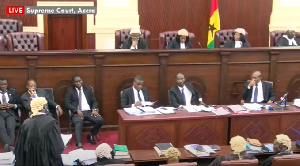Opinions of Wednesday, 9 August 2023
Columnist: Herman
The Whole truth of biblical salvation, Part 2 of 5
However, an additional covenant was made with the people of Israel, called a
blood covenant:
Exodus 24:8
And Moses took the blood and sprinkled it on the people, and said, Behold
the blood of the covenant, which the LORD hath made with you concerning
all these words.
With the blood covenant, if Israel were to break it, they were to die. If Yehovah were to break it, Yehovah was to die. Unfortunately, in less than two months, while Moses was on Mount Sinai speaking with God, Israel broke the covenant when they made and worshiped the golden calf.
God was going to kill them all and start over again with Moses (Exodus 32:7-14).
But Moses pleaded with Yehovah to “find another way”. So, God instituted the
appointed time of the Day of Atonement. It was the sixth feast (or modem) of seven, to be enacted every year on the tenth day of the seventh Hebrew month, called Tishri.
On that day, the high priest would sprinkle animal blood on the east end of the Ark of the Covenant, to give Israel forgiveness of sins for only the past year. The next year, it would have to be repeated. It was a yearly reminder (or placeholder) that the death penalty was still owed. Someone would still be required to die. It would have to be either all of Israel, or a third innocent party that had not broken the Torah (law).
Yehovah gave the promise that a Levite prophet, like Moses, would come, and the
people must obey him (Deuteronomy 18:15-18). In addition, about 570 years later,
God promised King David that his offspring would be the Messiah of Israel, and sit on the throne forever (2nd Samuel 7:12-17).
The marvel was, how to keep both promises. Israel didn’t know if it was going to be two different people or just one person. The only way a person could hold the office of both a high priest and of the king is if they were divine, such as Melchizedek (Genesis 14:18, Psalms 110:4).
Near the end of the House of Jacob’s exile in Babylon, in about 522 BC, the
archangel Gabriel came to Daniel to let him know that fulfillment of biblical
prophecy will occur over the course of a specified 490 years in the future of God’s people. The countdown for the end of sins, and the destruction of Satan will begin.
The prophecy is given in three levels. The first level speaks of prophetic 69 weeks, meaning 483 years when the Messiah will appear after the third wave of Hebrews leave Babylon.
Daniel 9:24-27
24 Seventy weeks are determined upon thy people and upon thy holy city, to
finish the transgression, and to make an end of sins, and to make reconciliation for iniquity, and to bring in everlasting righteousness, and to seal up the vision and prophecy, and anoint the most Holy.
25 Know therefore and understand, that from the going forth of the commandment to restore and to build Jerusalem unto the Messiah the Prince shall be seven weeks, and threescore and two weeks: the street shall be built again, and the wall, even in troublous times.
Again, the third wave of Hebrews to leave Babylon and cross the Euphrates River
was the first day of the first Hebrew month (Aviv) in the year 457 BC. While in
Babylon, the Pharisees changed the name of the first month to “Nisan”. The
Temple was completed 49 years later in 408 BC. That was the seven weeks. Sixty-
two prophetic weeks after that, or 434 years, in the year AD 27, on Saturday, March 29th, Yeshua Hamashiach crossed the Jordan River, coming from the wilderness, and John the Baptist then proclaimed Him to be the Messiah (John 1:29-30).
This was the second time in 42 days that John the Baptist had seen Yeshua. This
second time was on the first day of the first Hebrew month in AD 27, exactly 483
years from when Ezra and the company left Babylon. This concluded the first level of the prophecy. Now, we go to the second level of the prophecy.
26 And after threescore and two weeks shall Messiah be cut off, but not for
himself: and the people of the prince that shall come shall destroy the city
and the sanctuary; and the end thereof shall be with a flood, and unto the
end of the war desolations are determined.
Here is why many people do not understand the 70 weeks of Daniel. The second
level does not speak of years but begins to speak in terms of 7-day weeks. The
complete ministry of Yeshua was seventy weeks, or 490 days, not three and a half
years. Yeshua was baptized on Sunday, February 16, AD 27. Sixty-two actual
weeks later, which was 434 days, Yeshua rode into Jerusalem on a donkey on
Saturday morning April 24, AD 28. There was no Palm Sunday. Neither was there
any resurrection on Easter Sunday, but more about that in another article. His
ministry ended June 20, AD 28, when His Ghost was given to the 120 disciples.
The difference between a “ghost” and a spirit, is that a ghost is a spirit that has had human habitation.
On the following Wednesday, which was four days after Yeshua rode into Jerusalem, in the middle of the sixty-third week, Yeshua was crucified or cut
off. The nation of Judah lost the war against Rome in AD 68, not AD 70. Forty
years after Yeshua said that there would not be one stone left on top of another, the Temple was torn down. This concluded the second level, and we now go to the next verse.
And he shall confirm the covenant with many for one week: and in the midst of the week he shall cause the sacrifice and the oblation to cease, and for the overspreading of abominations, he shall make it desolate, even until the consummation and that determined shall be poured upon the desolate.
Now, the prophecy turns its full attention to the anti-Christ, which is the third level of the prophecy, and again speaks in terms of years. This is the 70th week, which begins the seven years of tribulation. But that is the subject of another article.













